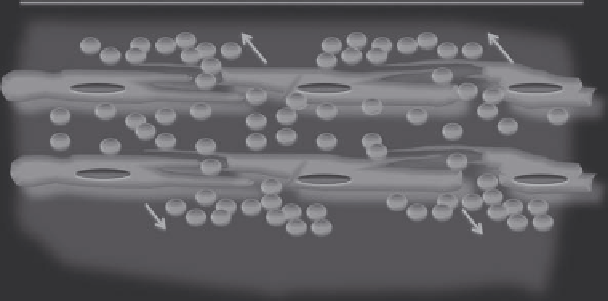Biomedical Engineering Reference
In-Depth Information
(a)
(b)
(c)
FIGURE 16.5
Effects of hyperthermia on nanoparticle extravasation from tumor microvessels. (a) Under normothermic conditions, a few lipo-
somes extravasate via the EPR effect, to heterogeneously collect in perivascular regions. (b) 40-42°C hyperthermia increases pore sizes between
endothelial cells, permitting greatly enhanced extravasation of liposomes into the interstitial space. The rate of extravasation doubles for every
°C between 40°C and 42°C. This effect does not occur in normal tissues, thereby providing potential for a therapeutic gain. (c) Thermosensitive
liposomes rapidly release content upon reaching their transition temperature, which bathes the heated zone in free drug, which can diffuse down
its concentration gradient to reach tumor cells. Elongated structures with interdigitating protrusions depict endothelial cells, circular structures
represent liposomes. Ellipsoidal structures depict endothelial cell nuclei. Size of liposomes is not drawn to scale. They are typically 100 microns or
1/100 the size of a red blood cell.
concentration achieved within individual tumors, as measured
by a noninvasive fluorescence spectroscopic method (Palmer
et al. 2010). This work also demonstrated the importance of
tumor oxygenation and perfusion in affecting tumor response
to LTSL-Dox + hyperthermia, as longer growth delays were seen
in tumors with higher hemoglobin content (which reflects blood
volume/perfusion) and hemoglobin saturation (which is related
to overall oxygenation status) (Figure 16.5).
Yarmolenko et al. compared the antitumor efficacies of hyper-
thermia + LTSL-Dox across several tumor lines (Yarmolenko
et al. 2010). LTSL-Dox with 42°C hyperthermia enhanced the
antitumor effect of all these tumor lines, compared with LTSL-
Dox alone, heat alone, or untreated controls, but the extent of
enhancement varied between tumor lines. In an attempt to
understand the reasons for variation, the authors investigated
the
in vitro
sensitivity to doxorubicin (as assessed by clonogenic
assay), the
in vitro
doubling time, intratumoral drug concentra-
tions, and intratumoral pH. The only parameter that was consis-
tently associated with the relative improvement in growth delay
was doubling time. Tumors with longer
in vitro
doubling times
tended to respond better and have longer response durations to
this treatment. The authors concluded that
a priori
knowledge of
tumor doubling time might prove useful in designing treatment
schedules for individual patients with this drug formulation.
16.6.2 Vascular targeting and HIF-1
Chen et al. reported that the efficacy of LTSL-Dox with hyper-
thermia may be related to its vascular targeting effects. Using
intravital microscopy, they showed that LTSL-Dox with








